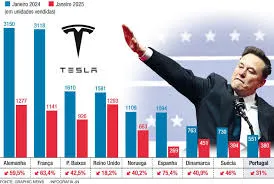
Political Backlash Causes 49% Drop in Tesla EU Sales
Tesla’s sales in Europe have experienced a significant decline in the early months of 2025. In January, the company registered only 9,945 vehicles across the EU, UK, and EFTA regions, marking a 45% drop from the 18,161 units sold during the same period in 2024. This downward trend continued into February, with reports indicating that Tesla’s European sales nearly halved compared to the previous year.
Several factors contribute to this decline:
- Political Backlash: Elon Musk’s political engagements have sparked controversy in Europe. His support for Germany’s far-right Alternative for Germany (AfD) party and involvement with former U.S. President Donald Trump’s administration have led to consumer resistance. In Germany, Tesla’s registrations fell to 1,277 vehicles in January, the lowest since July 2021, and France experienced a 63% decline, the worst since August 2022.
- Supply Chain Disruptions and Model Updates: Tesla’s Berlin factory underwent retooling in January to accommodate the production of the refreshed Model Y, known as Project Juniper. This transition impacted production schedules and vehicle availability. Additionally, the anticipation of the updated Model Y led potential buyers to delay purchases, further affecting sales figures.
- Intensified Competition: European automakers are rapidly expanding their electric vehicle offerings to meet stringent EU carbon-emission regulations. Companies like Volkswagen have introduced competitive EV models, leading to aggressive pricing strategies and increased market share at the expense of Tesla.
Despite Tesla’s sales slump, the broader European electric vehicle market has shown resilience. Battery-electric car sales across the region grew by 34% in January, reaching 124,341 units and capturing a 15% market share. This indicates that while the overall demand for electric vehicles remains strong, Tesla’s recent challenges have impacted its position within the European market.